Overhead Bridge Crane: Lifting Heights and Customization Options
Compare typical vs. large lifting heights; customize overhead bridge cranes for optimal industrial performance based on unique needs.
Category: Featured
Your Trusted Overhead Crane Manufacturer & Supplier
Overhead Bridge Crane: Typical Lifting Height vs. Large Lifting Height
Customized Industrial Overhead Crane for Your Needs,
Overview of Overhead Bridge Cranes
Importance of Overhead Bridge Cranes in Various Industries
An overhead bridge crane is a type of lifting equipment designed to move heavy loads across horizontal distances within a facility. It consists of a bridge that runs along two parallel rails mounted on either side of a building or workspace. The bridge moves horizontally, while a hoist (attached to the bridge) provides vertical lifting, allowing operators to raise and lower loads. This type of crane is widely used in industries where high-capacity lifting and precise control are essential.
Overhead bridge cranes are critical in industries such as manufacturing, automotive, steel production, aerospace, and shipping. In manufacturing plants, they are used to move heavy machinery, raw materials, or finished products across long distances with minimal effort. In steel production, for example, they help handle molten metal, which requires special design considerations for heat resistance and safety. These cranes provide significant operational benefits, including enhanced safety, increased efficiency, and improved productivity in environments that require frequent, precise lifting of heavy loads.
Their versatility and ability to handle large, heavy loads make them a vital piece of equipment in modern industrial operations, allowing businesses to improve workflow and reduce manual labor.
Lifting Height
Explanation of Lifting Height and Its Significance for Operational Efficiency
Lifting height refers to the maximum distance a crane can lift a load vertically from the floor to the underside of the crane's girder (the beam that holds the hoist). It is one of the most important factors when choosing a crane because it dictates how high the crane can lift materials, equipment, or products.
In practical terms, the lifting height affects an operation's efficiency in several ways:
- Space Utilization: A higher lifting height allows for better use of vertical space, enabling the crane to move loads to elevated areas and freeing up floor space for other activities.
- Load Handling Flexibility: With more lifting height, a crane can handle taller or bulkier items without restrictions. This is especially important in industries like construction, aerospace, or steel manufacturing, where large and heavy components need to be moved.
- Safety Considerations: Adequate lifting height is necessary for safe clearance around obstacles, such as machines, workstations, and personnel. Insufficient height can lead to safety hazards, like the risk of hitting overhead obstacles or making the workspace cramped and inefficient.
- Operational Efficiency: Cranes with sufficient lifting height enable smoother workflows, as materials can be lifted directly from storage areas to other workstations or staging zones. This reduces handling time, minimizes material congestion, and helps speed up the entire production process.
Why Lifting Height is a Key Factor in Crane Selection
Selecting the right lifting height is crucial because it directly impacts how effectively a crane can meet operational requirements. Factors to consider when determining the appropriate lifting height include:
- Load Size and Type: The type of load you need to lift often dictates the required height. Large or heavy objects may need more vertical space to be safely moved. For example, construction cranes moving long beams or automotive cranes handling engine components need to lift objects far off the ground to clear other equipment or machinery.
- Facility Layout: The height of your building or workspace is a key consideration. Taller buildings allow for cranes with larger lifting heights, but this must be balanced with factors like headroom and overall building design.
- Future Growth or Changes: It's important to plan for future needs. If your facility is expected to handle larger loads or taller items in the future, selecting a crane with a higher lifting capacity can save costs in the long term.
- Cost and Efficiency Trade-offs: While cranes with larger lifting heights often come at a higher price, they can improve productivity in certain applications. Balancing lifting height with budget constraints and operational needs is critical to selecting the right crane for your facility.
In conclusion, lifting height is a fundamental factor that determines the crane's ability to handle specific tasks efficiently and safely. By choosing a crane with the appropriate lifting height, businesses can optimize their operations, enhance productivity, and ensure a safer work environment.
Typical Lifting Height (6m to 30m)
What is Typical Lifting Height?
Typical lifting height refers to the standard range of lifting capacity found in many industrial overhead bridge cranes, typically ranging from 6 meters to 30 meters (about 20 to 100 feet). This range is considered the norm for most standard industrial and manufacturing operations.
These lifting heights are designed to handle general-purpose lifting tasks in various industrial settings, where moderate clearance is sufficient for safe and efficient material handling. The crane's lifting height is the vertical distance from the floor to the highest point a load can be lifted, which affects how effectively the crane can operate within the available workspace.
General Applications for Lifting Heights Between 6m to 30m
Manufacturing: Handling Standard Loads Like Raw Materials and Parts
Overhead cranes with lifting heights between 6m and 30m are commonly used in manufacturing facilities to move raw materials, parts, and semi-finished products along the production line. This height range is ideal for handling materials such as:
- Steel sheets
- Metal components
- Automotive parts
These cranes allow efficient transport while optimizing floor space for other operations, making them perfect for small to medium-sized items that don't require extreme vertical clearance.
Warehouse Operations: Efficient Stacking and Retrieval of Inventory
In warehouse environments, cranes within the 6m to 30m range are essential for:
- Stacking products
- Retrieving inventory
- Moving goods between different sections
These cranes are used for handling containers, pallets, and boxed goods, ensuring efficient storage and retrieval. The height allows for multi-level racking systems without overcrowding the warehouse floor.
Construction and Material Handling: For Moderate-Sized Projects
In construction, overhead cranes with lifting heights of 6m to 30m are ideal for lifting building materials like:
- Beams
- Concrete blocks
- Pipes
The range offers sufficient vertical clearance for lifting materials to upper floors or scaffolding, facilitating the movement of large components around construction sites.
Industries Using Typical Lifting Heights
Manufacturing
Overhead cranes with lifting heights between 6m and 30m are frequently used in manufacturing sectors such as automotive, steel production, and electronics. For example:
- Automotive plants commonly use cranes with a lifting height of 10m to 15m to move engine blocks or large metal parts.
- These cranes help reduce manual labor, improve safety, and speed up production.
Warehouse Operations
In logistics and distribution centers, cranes with lifting heights between 6m and 12m are used for tasks such as:
- Stacking pallets
- Retrieving items
- Loading/unloading containers
This range provides sufficient vertical clearance to maximize storage capacity while ensuring quick access to inventory.
Construction and Material Handling
In the construction industry, overhead cranes with 6m to 30m lifting heights are used to lift heavy materials such as:
- Steel beams
- Pipes
- Concrete blocks
A typical 15m to 20m crane allows construction sites to lift materials to higher floors or across scaffolding, ensuring efficient handling and assembly.
Advantages of Typical Lifting Heights
Lower Construction Costs for Buildings with Limited Vertical Space
Overhead cranes with lifting heights between 6m and 30m are ideal for facilities where high clearance is not needed. These cranes offer the following benefits:
- Reduced building height requirements
- Lower construction costs, as the ceiling doesn't need to be excessively tall
This is particularly advantageous for factories and warehouses where there's no need for extreme vertical reach.
Reduced Crane Complexity and Easier Maintenance
Crane systems with typical lifting heights are generally simpler to design and maintain. Key benefits include:
- Easier maintenance due to easier access to crane components like hoists, trolleys, and motors
- Lower operational costs as these cranes have fewer complex features and are less likely to need specialized repairs
This simplicity translates to reduced downtime and long-term costs for businesses.
Suitable for Most General-Purpose Applications
The versatility of overhead cranes with typical lifting heights makes them suitable for a variety of industries. They can handle:
- Automotive parts
- Raw materials
- Warehouse inventory
This makes them an affordable, reliable solution for businesses that need a crane for general-purpose tasks, without requiring extreme vertical reach.
Conclusion
Overhead cranes with lifting heights between 6m and 30m are a versatile, cost-effective solution for industries like manufacturing, warehousing, and construction. They offer a balance of efficiency, safety, and affordability, making them ideal for applications where moderate lifting heights are sufficient. Businesses can benefit from:
- Lower construction costs
- Simplified maintenance
- Increased operational efficiency
By selecting cranes in this lifting height range, companies can meet their material handling needs effectively while minimizing costs and complexity.
Large Lifting Height (30m to 70m and Beyond)
What is Considered a Large Lifting Height?
A large lifting height refers to cranes that can lift loads at vertical heights of 30 meters or more. These cranes are designed for specialized tasks that require a greater reach than standard cranes. Some cranes can reach heights up to 70 meters or even higher, depending on the application.
Examples of Large Lifting Heights:
- 30m Lifting Height: Common in industries needing more reach than standard cranes, but not extreme heights.
- 35m to 45m Lifting Height: Used in heavy manufacturing or large construction projects.
- 54m to 65m Lifting Height: Used in specialized industries like shipyards, aerospace, or power plants.
- 70m and Beyond: Rare and custom-built for specific large-scale projects, like offshore oil rigs or massive infrastructure construction.
Applications Requiring Large Lifting Heights
Heavy Manufacturing: For Large Equipment and Machinery
In industries like steel mills and automotive factories, cranes with lifting heights of 35m to 50m are essential to handle large, heavy components. These cranes are designed to move large machinery, equipment, or complete sub-assemblies, which require significant clearance for safe and efficient transport. Commonly handled items include:
- Steel coils
- Machinery parts
- Heavy sub-assemblies
These high-clearance cranes allow manufacturers to move bulky items across the production line with ease, ensuring safety and efficiency in the handling process.
Shipyards and Ports: For Loading and Unloading Large Cargo
In shipyards and ports, cranes with large lifting heights (45m to 50m) are critical for loading and unloading massive cargo. They are used for handling large shipping containers or heavy industrial equipment from or onto ships. These cranes provide the necessary vertical reach to handle oversized loads safely and efficiently, such as:
- Cargo containers
- Heavy industrial equipment
- Ship hulls
Their ability to handle large loads with ease makes them indispensable in maritime operations.
Aerospace and Aerospace Assembly: Handling Large Aerospace Components
Overhead cranes with lifting heights of 50m to 70m are crucial in the aerospace industry. These cranes are used to lift and position large, delicate aerospace components such as:
- Aircraft wings
- Fuselages
- Engines
Because these components are often too large for standard cranes, high-lifting cranes are essential for their safe handling during the assembly, testing, and maintenance processes.
Power Plants and Large Industrial Facilities: Servicing High-Clearance Areas
In power plants, refineries, and other large industrial facilities, equipment is often located in high-clearance areas. Cranes with lifting heights between 45m to 70m are needed to service and maintain large equipment, including:
- Turbines
- Boilers
- Pressure vessels
These cranes offer the extra reach required for maintenance and handling in areas that are difficult for standard cranes to access, making them ideal for these challenging environments.
Advantages of Large Lifting Heights
Ability to Handle Larger Loads and More Complex Tasks
Cranes with large lifting heights are specifically designed to handle larger, heavier loads. In environments such as shipyards, cranes with 50m lifting heights are used to lift entire ship hulls, while in aerospace, cranes with 70m lifting heights move large aircraft components during assembly. These cranes offer:
- Increased capacity for oversized loads
- Enhanced capability for handling complex tasks that require significant clearance
Ideal for High-Clearance Facilities and Operations Needing Extreme Reach
Large lifting height cranes are perfect for operations in high-clearance environments like shipyards, power plants, and aerospace facilities. Their vertical reach allows them to:
- Lift materials to elevated platforms
- Clear tall obstacles or structures
- Service hard-to-reach areas that standard cranes cannot access
This makes them essential for facilities with tall structures or high clearance requirements.
Improved Efficiency in Large-Scale Production and Heavy-Duty Operations
In industries like steel mills or aerospace, large lifting height cranes improve operational efficiency. For example:
- In steel mills, cranes with 50m to 65m lifting heights can quickly move large steel beams and coils across the production line, improving workflow.
- In aerospace, cranes facilitate the rapid assembly of large parts, reducing downtime and improving productivity.
These cranes not only reduce the risk of accidents but also ensure smoother operations by providing greater vertical reach for heavy-duty tasks.
Overhead cranes with large lifting heights ranging from 30m to 70m are essential for industries that require the ability to lift heavy, oversized items in high-clearance environments. Whether it's in heavy manufacturing, shipyards, aerospace, or power plants, these cranes provide the necessary reach, capacity, and efficiency to handle complex tasks safely and effectively. They improve operational speed, reduce risk, and ensure smoother workflows, making them an indispensable tool for large-scale operations.
Customized Industrial Overhead Cranes for Your Needs
Why Choose a Customized Crane?
Opting for a customized industrial overhead crane allows you to tailor the crane's design to meet the specific needs of your operations and facility requirements. Customized cranes offer significant advantages over off-the-shelf models by ensuring that all critical factors, such as lifting height, load capacity, and operational environment, are optimized for your specific use case.
A customized crane is ideal for addressing unique challenges within your facility, such as limited headroom, the need for higher load capacities, or special facility dimensions that standard cranes may not accommodate. Whether you are operating in a congested manufacturing space, dealing with heavy-duty lifting requirements, or working in an environment that demands specialized features, a customized crane can provide the perfect solution.
Factors Influencing Customization
Headroom: Maximizing Available Space
Headroom refers to the vertical space available within a facility, which plays a crucial role in crane customization. When headroom is limited, it's essential to design a crane that fits within these height restrictions while still providing sufficient clearance for lifting operations. Custom cranes can be tailored to maximize this available space, allowing for efficient material handling without exceeding the headroom limits.
- Optimizing vertical space
- Efficient lifting with clearance constraints
- Tailored designs for compact facilities
Load Capacity: Tailoring to Material Size and Weight
Load capacity is a key factor in crane customization. The right capacity must be selected based on the size and weight of the materials being lifted. Industries like steel manufacturing or heavy machinery production often require cranes with higher load capacities, as standard models may not be equipped to handle large or heavy components. Customized cranes ensure that lifting capacities are tailored to meet operational needs, allowing for safe and efficient handling of even the heaviest materials.
- Custom lifting capacities for heavy materials
- Industry-specific requirements (e.g., steel, aerospace)
- Ensuring safe and efficient handling
Operational Environment: Special Design for Extreme Conditions
The operational environment significantly impacts crane customization. Cranes working in harsh conditions—such as extreme temperatures, high humidity, or corrosive environments—require specific design modifications. For example, cranes in chemical plants or offshore oil rigs may need additional anti-corrosion coatings or specialized materials to ensure they can withstand these conditions. Customization ensures the crane's durability and reliability in challenging environments.
- Adaptation to extreme temperatures and humidity
- Anti-corrosion coatings for harsh environments
- Long-term performance in difficult conditions
Lifting Speed and Frequency: Optimizing Performance
In industries such as aerospace or construction, lifting speed and frequency are crucial factors for efficiency. Cranes used in these sectors may need to complete rapid and frequent lifting cycles to meet production demands. Customized cranes can be designed with high-performance motors and optimized lifting mechanisms to enhance speed and frequency, ensuring smooth operations without compromising safety or reliability.
- Optimized for high-speed lifting cycles
- Tailored for high-frequency operations
- Enhanced motors for better performance
Examples of Custom Features
High Lifting Heights for Specialized Tasks
Certain applications demand cranes with high lifting heights, such as those in the aerospace or construction industries. For example, cranes that need to handle large aircraft components (like wings and fuselages) require significant vertical reach. Custom cranes can be designed with lifting heights of 45m to 70m to accommodate these specialized tasks, ensuring efficiency in high-clearance environments.
- Cranes with lifting heights up to 70m
- Handling oversized components
- Essential for specialized tasks in aerospace and construction
Anti-Corrosion Treatments for Harsh Environments
For operations in corrosive environments, such as chemical plants, shipyards, or marine settings, anti-corrosion treatments are essential. Customized cranes can be equipped with materials resistant to corrosion, such as galvanized steel or special coatings, which help protect the crane from the damaging effects of chemicals, saltwater, or extreme temperatures. This reduces maintenance costs and extends the crane's lifespan in harsh conditions.
- Corrosion-resistant materials
- Protection against chemicals, saltwater, and extreme temperatures
- Extended crane lifespan and reduced maintenance
Enhanced Safety Features
Safety is a top priority in industrial operations, and customized cranes can be equipped with advanced safety features. Some of the key safety features include:
- Load limiters: Prevent overloading and ensure safe operation by keeping the crane within safe weight limits.
- Remote controls: Allow operators to control the crane from a safe distance, minimizing the risk of accidents.
- Explosion-proof options: Designed for hazardous environments like oil refineries or mining operations, where explosive materials may be present. These cranes are designed to prevent ignition and ensure safe operation in volatile conditions.
- Safety-first customization
- Advanced protective features for high-risk environments
- Ensuring operator safety through remote control options
By considering these factors and customizing cranes for your specific needs, you can ensure that your lifting operations are safe, efficient, and well-suited to the unique challenges of your facility.
In conclusion, a customized industrial overhead crane is an essential solution for businesses with specific lifting needs, unique facility requirements, or challenging operating environments. By customizing the crane's lifting height, load capacity, operational features, and safety specifications, you can ensure the crane meets the exact demands of your operations, improving efficiency, safety, and long-term reliability. Whether you need a crane for high-clearance applications, extreme environmental conditions, or heavy-duty lifting tasks, customization allows you to optimize your crane's performance and ensure it works seamlessly within your industrial setup.
Comparison of Typical vs. Large Lifting Heights
Performance and Capabilities
When comparing typical lifting height cranes (6m to 30m) with large lifting height cranes (30m to 70m or more), the performance and capabilities differ significantly. Each type of crane is designed to meet specific operational needs, with large lifting height cranes focusing on handling bigger loads and lifting to greater heights.
- Typical Lifting Height Cranes: Ideal for general-purpose tasks in facilities with moderate production demands. These cranes are versatile, designed to handle standard loads and provide reliable service for most industrial applications.
- Large Lifting Height Cranes: Specifically engineered for industries with complex lifting requirements, such as aerospace, shipbuilding, and power plants. These cranes offer greater lifting capacities and vertical reach, essential for handling oversized components or materials that require high clearance.
Lifting Speed and Capacity
Typical Lifting Height Cranes:
- Lifting Speed: Moderate, designed for everyday tasks.
- Lifting Capacity: Typically handles up to 50 tons, suitable for general manufacturing, warehouses, and construction sites.
- These cranes are cost-effective and provide sufficient performance for standard industrial operations without the need for extreme heights.
Large Lifting Height Cranes:
- Lifting Speed: Slower lifting speeds due to higher capacities and more complex lifting mechanisms.
- Lifting Capacity: Capable of handling loads over 100 tons, often used in aerospace, shipyards, and other heavy industries.
- The primary advantage of these cranes is their ability to lift massive components with precision over greater distances and heights.
Operational Flexibility
Typical Lifting Height Cranes:
- Best for medium-duty operations where vertical reach isn't a priority. These cranes offer flexibility to handle a wide variety of materials and are ideal for environments such as warehouses and manufacturing facilities with standard lifting requirements.
- Versatile in handling raw materials, machinery parts, and inventory.
Large Lifting Height Cranes:
- Highly specialized for high-clearance operations, such as lifting large, heavy components in industries like aerospace, shipbuilding, and energy production.
- Offer flexibility in handling oversized materials or machinery across multiple levels or from high platforms, which is critical for operations that require extreme lifting heights.
Cost Considerations
Cost is a significant factor in the decision to choose between typical and large lifting height cranes. This includes construction costs, operational costs, and maintenance costs.
Construction Costs
- Typical Lifting Height Cranes:Lower Construction Costs: These cranes are easier and cheaper to build, as they don't require complex structures or specialized components. Standard buildings can accommodate these cranes with minimal modifications.
- Large Lifting Height Cranes:Higher Construction Costs: These cranes require reinforced building structures, taller clearance spaces, and specialized foundations, making their construction more expensive. The crane design itself is more intricate, with stronger motors and larger lifting systems.
Operational Costs
Typical Lifting Height Cranes:
- Lower Operational Costs: Typically cheaper to operate, as they have simpler designs, lower power consumption, and fewer components to maintain. They are highly efficient for regular tasks.
Large Lifting Height Cranes:
- Higher Operational Costs: These cranes consume more power due to their larger motors and complex lifting systems. They also require more frequent maintenance, though their robust design may offset some costs over time.
Maintenance Costs
Typical Lifting Height Cranes:
- Lower Maintenance Costs: With fewer specialized components and simpler systems, these cranes are less expensive to maintain. Spare parts are readily available and maintenance intervals are more frequent but less intensive.
Large Lifting Height Cranes:
- Higher Maintenance Costs: Due to their complexity and high usage in heavy-duty environments, large cranes require more intensive maintenance. Custom-designed parts may be needed, leading to higher repair costs and longer downtime.
Space and Facility Requirements
The design of your facility impacts the crane selection process, as both types have different space and height requirements.
Typical Lifting Height Cranes
- Standard Facility Design: These cranes work well in standard buildings with lower ceilings (usually 6 to 9 meters). They don't require specialized clearance, making them ideal for general industrial settings with limited vertical space.
- Simple Setup: These cranes can be integrated into most facilities without requiring significant structural adjustments.
Large Lifting Height Cranes
- High-Clearance Facilities: These cranes require buildings with taller ceilings, reinforced structures, and additional space for clearance. Industries like aerospace, shipbuilding, or power generation need facilities that accommodate the crane's lifting height and range.
- Additional Space for Operations: These cranes may need extra room for loading docks or multi-level operations, ensuring safe and effective movement of large materials.
Operational Efficiency
Crane efficiency is directly linked to the workflow, load handling, and overall productivity of your facility.
Typical Lifting Height Cranes
- Ideal for General Operations: These cranes provide efficient material handling for standard industrial tasks. Their moderate lifting speeds and capacities are perfect for warehouses, automotive assembly, or small manufacturing.
- Enhance Workflow: They improve productivity by efficiently handling loads without the need for extreme heights or heavy lifting capacities.
Large Lifting Height Cranes
- Optimized for High-Clearance and Large-Scale Operations: These cranes are crucial for industries that require the movement of heavy-duty materials or machinery over significant heights. While their lifting speeds may be slower than typical cranes, they offer essential functionality in aerospace, shipyards, and power plants.
- Improve Productivity for Complex Tasks: These cranes optimize workflow in specialized industries where the primary focus is on lifting large components between elevated platforms or across multiple levels.
Summary
Choosing between typical and large lifting height cranes depends on your facility's needs, budget, and the type of materials you handle.
- Typical Lifting Height Cranes are best for standard industrial tasks, offering lower costs and greater efficiency in environments with limited vertical space.
- Large Lifting Height Cranes are designed for heavy-duty operations in high-clearance environments, providing greater lifting capacities and vertical reach for specialized industries like aerospace, shipbuilding, and power generation.
By understanding the differences between these crane types, businesses can make informed decisions based on their specific needs, ensuring efficient and safe operations.
Choosing the Right Crane for Your Facility
Selecting the right crane for your facility is a critical decision that can significantly impact your operational efficiency, safety, and long-term costs. An informed choice ensures that your crane system not only meets your current needs but also adapts to future demands. Below, we highlight the key considerations and common mistakes to avoid when choosing the perfect crane for your facility.
Key Considerations
Assessing Your Lifting Requirements
Before selecting a crane, it's essential to fully understand your lifting needs. This involves evaluating the following:
- Load Size: Determine the heaviest load your crane will need to lift. It's vital to select a crane that can handle this weight, including occasional overloads, to ensure safety margins are met. Make sure to account for both static and dynamic load requirements.
- Load Type and Shape: Consider the physical shape of the items being lifted. Irregularly shaped or oversized loads may require specific crane features, such as adjustable hooks, lifting beams, or custom lifting attachments to ensure proper handling.
- Building Dimensions: Understanding the physical space in your facility is crucial. If your operations require lifting large or high-clearance materials, you may need a crane with a higher lifting capacity and greater range. Ensure that the crane fits within the structural limits of your building.
Selecting the Correct Lifting Height
Lifting height plays a pivotal role in crane selection. Factors to consider include:
- Type of Work: For standard material handling tasks (such as in warehouses or automotive manufacturing), a typical lifting height (6m to 30m) is usually sufficient. However, operations that require lifting heavy equipment or operating in high-clearance environments (e.g., shipyards, power plants) will need cranes with lifting heights above 30m.
- Clearance Needs: Ensure you have enough building clearance to accommodate the crane's lifting height. This includes factoring in headroom space and ensuring that the crane can operate within the designated height limits without causing facility damage or safety hazards.
- Future Expansion: If you anticipate growth in your facility or lifting needs, it may be wise to opt for a crane with greater lifting height capacity. This allows for easier adaptation to future requirements, saving costs on upgrading the crane later.
Common Mistakes to Avoid
Overestimating or Underestimating the Necessary Lifting Height
- Overestimating the Height: Choosing a crane with an unnecessarily high lifting height can lead to wasted costs, as you'll be paying for features and modifications you don't need. These additional capabilities can result in excess energy consumption and added maintenance.
- Underestimating the Height: Underestimating the required lifting height can lead to operational inefficiencies, safety risks, and potential damage to both the crane and the facility. Ensure you select a crane that can handle the tallest loads you expect to lift and leaves room for future growth.
It's essential to carefully calculate your lifting height needs based on the loads and tasks in your facility, considering both current and future requirements.
Failing to Account for Future Needs or Facility Expansions
Crane selection should account for long-term growth and future demands. Here's why:
- Space for Future Equipment: As your facility grows, you may need to introduce new machinery or alter workflows. Ensure that your crane can accommodate these potential changes without requiring a costly replacement.
- Increased Lifting Requirements: Operations may evolve over time, requiring more lifting capacity or greater height. Choosing a crane with modular upgrades or one that can handle additional weight or height in the future can help avoid unnecessary costs down the line.
- Facility Upgrades: Plan ahead for any necessary facility upgrades, such as reinforced floors or higher ceilings, if you anticipate a need for larger cranes. Avoid the risk of outgrowing your crane before its full lifecycle is complete.
Ignoring the Importance of Safety Features and Ease of Maintenance
Cranes are complex machines that require ongoing maintenance and safety considerations. Failing to prioritize these factors can lead to inefficiencies and even accidents.
Safety Features: Select cranes that come equipped with essential safety features, such as:
- Load Limiters: Prevent overload by ensuring the crane doesn't lift beyond its capacity.
- Emergency Stop Systems: Allow operators to stop crane operation immediately in case of an emergency.
- Anti-Collision Systems: Help avoid accidents by ensuring safe operation in areas with limited space or when multiple cranes operate simultaneously.
- Explosion-Proof Components: For industries like oil & gas or construction, explosion-proof features are critical for preventing accidents in hazardous environments.
Ease of Maintenance: Cranes require regular inspection and maintenance to ensure optimal operation. Choose a crane with easily accessible components, simple lubrication systems, and readily available spare parts. Regular maintenance helps extend the crane's lifespan and reduces downtime.
Training and Support: Ensure your team is adequately trained to operate and maintain the crane safely and efficiently. Additionally, work with a crane supplier that offers strong after-sales support, including technical assistance, maintenance services, and training programs for operators.
Choosing the right crane for your facility is a significant investment that requires careful evaluation of your operational needs, facility specifications, and future plans. By considering key factors like load capacity, lifting height, safety features, and potential expansions, you can ensure that your crane meets both current and future demands effectively and efficiently.
Avoid common mistakes such as overestimating or underestimating lifting height, failing to account for future needs, and overlooking safety features. By making a well-informed decision, you can avoid costly setbacks, enhance productivity, and improve safety in your operations.
Conclusion
Choosing the right crane for your facility requires a clear understanding of your operational needs. The key differences between typical lifting height cranes (6m to 30m) and large lifting height cranes (30m to 70m or more) lie primarily in the scope of work, load capacity, and facility requirements.
- Typical lifting height cranes are ideal for general-purpose tasks that require moderate vertical reach, such as material handling in warehouses, factories, and construction sites.
- Large lifting height cranes, on the other hand, are designed for industries that demand greater lifting capacity, high-clearance operations, or specialized tasks such as lifting heavy machinery, aerospace components, or shipyard operations.
By understanding the specific nature of the work you do, the size and weight of the loads you need to lift, and the height requirements of your facility, you can make an informed decision on whether a typical or large lifting height crane is the best fit.
Final Recommendations
- For typical operations: Standard lifting heights ranging from 6m to 30m will likely meet the needs of most general-purpose industrial tasks. This is ideal for industries like automotive manufacturing, warehouse operations, and construction, where moderate lifting heights are sufficient.
- For larger and more specialized tasks: Cranes with lifting heights of 30m to 70m, or even customized solutions, are recommended for industries that handle oversized equipment or require high-clearance operations. These are especially useful in shipyards, aerospace assembly, power plants, or any facility where significant vertical reach is necessary to lift heavy loads over multiple levels or complex environments.
When selecting the right crane for your needs, it's crucial to consult with a crane supplier or engineer to ensure that the crane meets your specific requirements. Whether you're looking for a crane with a typical lifting height or a custom solution for specialized tasks, a professional consultation will help you determine the ideal crane that ensures operational efficiency, safety, and cost-effectiveness.
Don't hesitate to get in touch with experts who can guide you through the design and selection process to ensure your crane system is perfectly tailored to your facility's needs.
Main Projects
Related Products

Supplied three grab bucket crane kits to Indonesia, enhancing garbage handling efficiency with high load capacity and reliable performance.
Free consultation to Confirm Parameters & Specifications and Get
Latest Crane Price & Crane Rate.
- Types of overhead cranes : _______?
- Optional: Overhead travelling crane, goliath gantry crane,Slewing jib crane, Single girder or double girder crane,small portable crane or kbk crane, etc.
- Capacity of overhead crane: _______?
- Optional: 0.25ton, 0.5 ton, 1 ton, 2 ton, 3ton, 5 ton, 10 ton,15ton, 20ton, 25 ton, 30ton,35ton, up to 550ton, etc.
- Crane span & lifting height : _______?
- Crane travelling length : _____?
- Control of overhead crane:_______?
- Optional: pendant/ remote/cabin control
- Voltage supply of overhead crane:_____?
- Eg,: 380V50/60HZ,3Phase or others,etc.
- Application/usage of crane:_______?
- Eg,: Steel mill, ,injection mold, cement,stone, concrete,granite, general manufacturing, etc.
Just leave a message via the contact form and our hoist and crane engineer will contact you with in 24working hours.
Get In Touch













